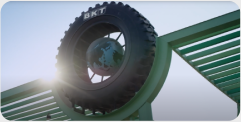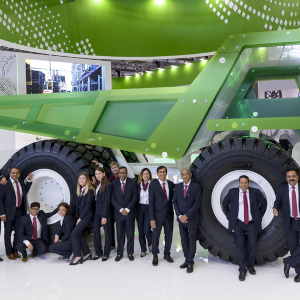Many solutions have been developed over the years to limit the damaging effects of soil compaction, but are not able to entirely solve the problem. So, here’s a comeback straight from the ‘80s: Controlled Traffic Farming!
Everybody knows that soil compaction is the number one enemy for farmers. Farmers have a lot of daily challenges to face, so why does this issue often outrank the others? Well, soil compaction limits gas exchanges (i.e. the exchange between gasses present in the soil and the atmosphere), water infiltration and the development of micro and macro organisms in the soil. What’s more, pesky compaction diminishes root growth and alters the PH value of the soil. Unfortunately, given the nature of farming, soil compaction is unavoidable. It is simply caused by the excessive pressure of machines driving across the fields - which is only worsening as machines become heavier and heftier over time.
Many solutions have been developed over the years to limit these effects, but are not able to entirely solve the problem. So, here’s a comeback straight from the ‘80s: Controlled Traffic Farming! Has the penny dropped? Not yet? Let’s find out together.
Controlled Traffic Farming: Defined
Despite dating back numerous decades, Controlled Traffic Farming (CTF) is one of the most advanced agronomic techniques. It’s a crop management system that separates crop areas from transit areas, thus dividing the field into “stripes”. Soil compaction is, therefore, confined to these narrow strips of land, whereas crops can continue to flourish on the undamaged soil. This clear separation limits the traffic on farming land - thus also limiting soil compaction.
Additionally, reserving entire soil areas makes it possible to reduce the intensity of soil tillage, to limit the use of fertilizers or other agents, to decrease energy consumption per unit of harvested product, and to foster the ecological soil balance. All in all, controlled traffic farming is a win-win in our eyes!
Today, precision farming and automatic guidance systems can be used to implement this technique, detecting transit lanes with the highest accuracy. For instance, a “smart” spreader, equipped with an automatic guidance system, receives GPS coordinates and travels across the field on the exact same path. Neat! However, if advanced technology isn’t for you, you can still implement controlled traffic farming through traditional marking systems. This can be achieved simply by matching up machinery tracks!
The Benefits of Controlled Traffic Farming
To recap, there are a plethora of benefits to controlled traffic farming - beyond reducing soil compaction. There’s a reason why this process has stood the test of time!
First, it increases the sustainability of your day-to-day processes on the farm, allowing farmers to reduce energy consumption during soil preparation activities. All in all, controlled traffic farming also improves your soil’s conditions and fertility, and increases your yield. It also reduces the use of weed killers and chemical fertilizers, whilst optimizing farming machinery operations - allowing farmers to have better lay of the land!
In a nutshell, controlled traffic farming allows farmers to exert more control over numerous factors on the field - which, therefore, improves their overall operations tenfold. Can you tell that we’re big fans?
BKT recommends: Agrimax RT 600
BKT is well aware of the fact that each application needs the right tire. So, if you are looking for a buddy to implement controlled traffic farming with your spreaders, we suggest using Agrimax RT 600.
This radial tire is perfect - even on delicate soils - ensuring the least possible impact. Its wide contact area provides an optimized weight distribution, protects the soil and favors both yields and cost-effective business. Agrimax RT 600: a strong and resistant tire for your fields - with the ability to be soft and sensitive when needs be!
To find out more and to learn about all the available sizes, just visit our website!








.jpg)